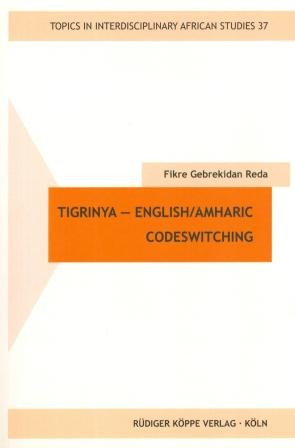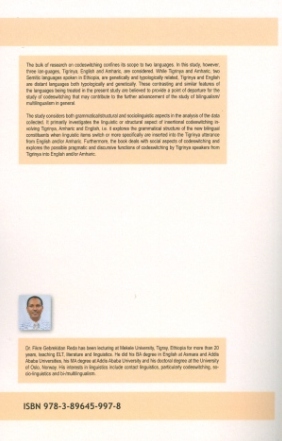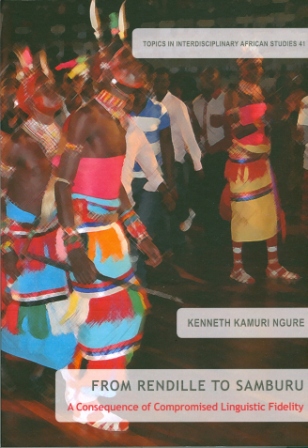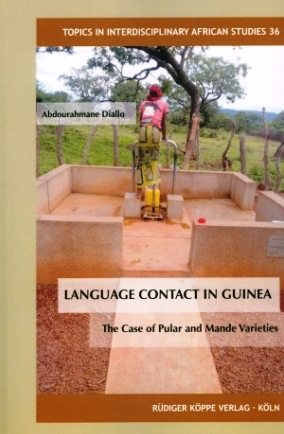



Tigrinya–English/Amharic Codeswitching
Author: Fikre Gebrekidan Reda.
Series: TIAS Topics in Interdisciplinary African Studies Volume 37
201514 pp. Roman, 235 pp.
2 colour maps, 6 diagrams/figures, numerous tables and charts, appendices: transcripts of recordings, questionnaire
Text language(s): English
Format: 160 x 230 mm
470 g
Paperback
€ 59.80
Buy 'Tigrinya–English/Amharic Codeswitching' as a downloadable PDF document directly from our online shop »
Order 'Tigrinya–English/Amharic Codeswitching' as print edition »
The bulk of research on codeswitching confines its scope to two languages. In this study, however, three languages, Tigrinya, English and Amharic, are considered. While Tigrinya and Amharic – two Semitic languages spoken in Ethiopia – are genetically and typologically related, Tigrinya and English are distant languages both typologically and genetically. These contrasting and similar features of the languages being treated in the present study are believed to provide a point of departure for the study of codeswitching that may contribute to the further advancement of the study of bilingualism/multilingualism in general.
The study considers both grammatical/structural and sociolinguistic aspects in the analysis of the data collected. It primarily investigates the linguistic or structural aspect of insertional codeswitching involving Tigrinya, Amharic and English, i.e. it explores the grammatical structure of the new bilingual constituents when linguistic items switch or more specifically are inserted into the Tigrinya utterance from English and/or Amharic. Furthermore, the book deals with social aspects of codeswitching and explores the possible pragmatic and discursive functions of codeswitching by Tigrinya speakers from Tigrinya into English and/or Amharic.
CONTENTS:
Chapter 1: General Introduction ~~ Chapter 2: Review of Literature ~~ Chapter 3: Research Methods ~~ Chapter 4: Background to the Languages ~~ Chapter 5: Analysis and Discussion ~~ Chapter 6: Verb Codeswitching in Tigrinya ~~ English/Amharic ~~ Chapter 7: Analysis of Discursive Functions of Codeswitching and Discussion of the Questionnaire Results ~~ Chapter 8: Conclusion
Fikre Gebrekidan Reda has been lecturing at Mekele University, Tigray, Ethiopia for more than 20 years, teaching ELT (English language teaching), literature and linguistics. He did his BA degree in English at Asmara and Addis Ababa Universities, his MA degree at Addis Ababa University and his doctoral degree at the University of Oslo, Norway. His interests in linguistics include contact linguistics, particularly codeswitching, sociolinguistics and bi-/multilingualism.
Under these links you will find further analyses of codeswitching and language contact in Africa, as well as a comprehensive bibliography of Tigrinya:
Accompanying material:
- Codeswitching in Gambia
(ISBN 978-3-927620-24-7 ) - Essentials of Amharic
(ISBN 978-3-89645-573-4 ) - Language Contact and Language Change in Ethiopia
(ISBN 978-3-89645-258-0 ) - Language Contact in Guinea
(ISBN 978-3-89645-906-0 ) - Tigrinische Bibliographie
(ISBN 978-3-89645-688-5 )
Cross-reference:
- Die Verbalsysteme des Amharischen und Tigrinischen
(ISBN 978-3-89645-687-8 ) - Language Change under Multilingual Conditions
(ISBN 978-3-89645-724-0 ) - Linguistic Landshapes
(ISBN 978-3-89645-085-2 ) - Tsotsitaal in South Africa
(ISBN 978-3-89645-086-9 )
Reviews
What is unique about this work is the fact that while most texts on codeswitching describe the phenomenon within language pairs, the author of this study takes into consideration three languages: two of them are closely related, i.e. Tigrinya and Amharic, and one genetically and typologically distant, i.e. English. Multicultural and multilingual Ethiopia is/presents a perfect field of research into bi- or trilingualism, particularly with respect to codeswitching, as most of its inhabitants are naturally predestined to speak more than one language. [...] The book is certainly a valuable addition based on meticulous research and extensive references, and it fills a significant gap in linguistic literature on language contact in Ethiopia.
Ewa Wolk-Sore in Studies of the Department of African Languages and Cultures, 51/2017, 135-138
Der Autor setzt sich sehr gewissenhaft mit den behandelten Themen auseinander. Seine Ausführungen sind stets gut nachvollziehbar und die zitierte Literatur ist beachtlich. Die Wahl dieser drei Sprachen (Tigrinisch, Amharisch und Englisch) für die Erforschung des Kodewechsels erwies sich als überaus effektiv. Fikre Gebrekidan Reda ist es mit dieser Arbeit gelungen, zum einen relevante Forschungsergebnisse zur Sprachkontaktforschung und zum anderen zum besseren Verständnis der gesprochenen tigrinischen Sprache beizutragen. Dieses Buch ist daher allen an der Sprachkontaktforschung und der tigrinischen Sprache interessierten Lesern sehr zu empfehlen.
Marlene Guss-Kosicka in Orientalistische Literaturzeitung, 113/3, 2018, 239-241
| « back | Print version | [top] |
 Books
Books Audio
Audio Biographies
Biographies Series
Series Festschrifts
Festschrifts Journals
Journals